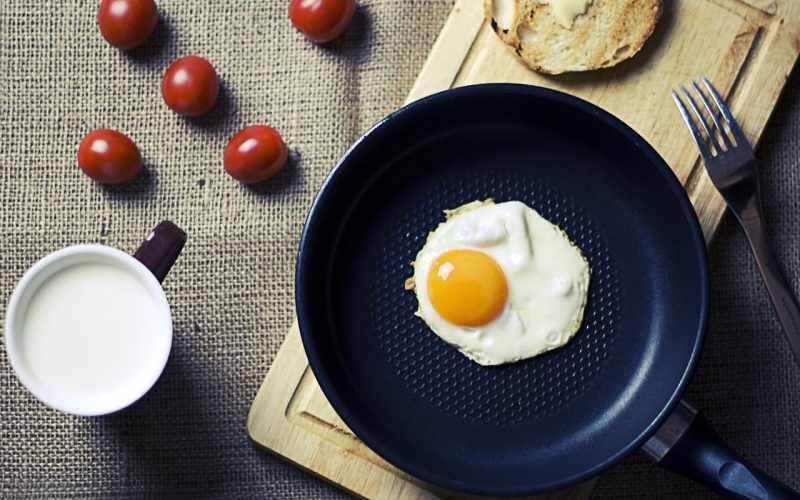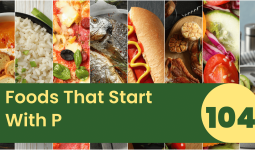Pans are one of the oldest cooking utensils that are still used today.
They are durable, in the sense that they are easy to maintain, and their non-stick surfaces. However, there are different types of pans.
Pan is not a single item but a group of different cookware items you can use for various things.
Anyone who likes to cook good food would agree that one of the most important things you can do to be a better cook is to have a good set of pots and pans.
This article will review some of the different types of pans available in the market.
Different Types of Pans
There are many different types of pans, each designed for specific cooking purposes. Here are some of the most common types:
1. Frying Pan/ Skillet
The frying Pan is one of the different types of pans we use for cooking.
It is typically a shallow, round, flat-bottomed pan with sloping sides flaring outward.
Frying pans are versatile, and you can use them for various cooking techniques, including sautéing, searing, frying, and pan-roasting.
Frying pans are available in different materials, including stainless steel and copper. Each of them with its advantages and disadvantages.
Stainless steel frying pans are durable, easy to clean, and non-reactive, making them suitable for cooking acidic foods.
Cast iron frying pans are excellent for searing and can go from stovetop to Oven. Aluminum frying pans heat up quickly and is lightweight but can warp over time.
A frying pan is an essential kitchen tool that can help you quickly cook various dishes.
2. Sauté Pan
A sauté pan is one of the different types of pans we use for cooking. It is similar to a frying pan but with higher vertical sides and a flat bottom.
The sides of a sauté pan are straight up and down, while the sides of a frying pan slope outwards.
They designed Sauté pans for cooking techniques that involve tossing and stirring ingredients in the Pan, such as sautéing, searing, and pan-roasting.
The higher sides of the Pan make it easier to start and toss ingredients without spilling them.
Sauté pans are available in various materials, including stainless steel and copper.
Each of them with its advantages and disadvantages. Stainless steel sauté pans are durable, easy to clean, and non-reactive, making them suitable for cooking acidic foods.
Cast iron sauté pans are excellent for searing and can go from stovetop to Oven.
3. Saucepan
A saucepan is one of the different types of pans. It is a deep, straight-sided pan with a flat bottom and a long handle.
We use Saucepans for cooking liquids, such as sauces and stews, but you can also use them for boiling, steaming, and blanching.
They are available in various materials, including stainless steel, aluminum, and non-stick coatings, each with advantages and disadvantages.
Stainless steel saucepans are durable and non-reactive, making them suitable for cooking acidic foods.
Aluminum saucepans heat up quickly and are lightweight but can warp over time.
However, copper saucepans are great conductors of heat, and they can be expensive. Non-stick saucepans are easy to clean and require less oil for cooking.
They are available in different sizes, ranging from small saucepans for heating milk or making sauces to large ones for cooking soups and stews.
A saucepan is a versatile kitchen tool that can help you quickly cook various dishes.
It’s an essential tool in any kitchen, and it’s worth investing in a good quality one that will last you for years.
4. Grill Pan
A grill pan is a pan that has a grill-like surface with raised ridges or bars. It cooks food generally cooked on a grill, such as meats, vegetables, or fish.
They made Grill pans from different materials, including cast iron, aluminum, or steel.
They made them with a non-stick material like Teflon to prevent food from sticking to the Pan.
You can use Grill pans on the stovetop or in the Oven, often creating grilled-like marks on food.
5. Wok
A wok is a pan that originated in China, and we use it in preparing Chinese cuisine.
It is a versatile pan for various cooking methods, including stir-frying, deep-frying, and even smoking.
Woks have a distinctive shape, with a round bottom and sloping sides flaring outward.
This shape allows for quick, easy stirring and tossing of ingredients. Woks are typically made of durable carbon steel, which conducts heat well.
Several types of woks are available, including traditional round-bottomed and electric woks.
Some woks also have a non-stick coating, which makes them easier to clean. Overall, woks are a popular and versatile type among the different types of pans.
6. Dutch Oven
A Dutch oven is a cast iron pan with a tight-fitting lid. It is versatile, and you can use it for various cooking methods, including baking, roasting, and frying.
You can use Dutch ovens on the stovetop and range, making them popular for one-pot meals.
Dutch ovens come in various sizes, from miniature 2-quart versions to larger 7-quart models.
We often use them for cooking stews, soups, and chili, as well as for baking bread, cobblers, and casseroles.
The thick walls and lid of a Dutch oven retain heat and moisture, which helps to cook food evenly and keeps it moist.
However, we also use them for camping and outdoor cooking, as you can use them directly on a fire or a portable stove.
7. Crepe Pan
A crepe pan is a pan among the different types of pans, which is for making crepes.
They are made from aluminum or copper and have a smooth surface to prevent crepes from sticking.
However, the Pan is also usually shallower than a regular frying pan so that the crepes can cook evenly on both sides.
You must invest in a good quality crepe pan to make perfect crepes at home.
However, many different crepe pans are on the market, so choosing one that suits your needs is essential.
For example, if you have a gas stove, you’ll need a pan compatible with that heat source.
Similarly, if you want to make large crepes, you’ll need a big pan to accommodate them. Once you’ve found the perfect Pan, making crepes at home will be a breeze!
8. Omelette Pan
An omelet pan is a specialized pan designed specifically for making omelets. It is typically a small, shallow pan with a flat bottom and slightly sloping sides.
However, they make the Pan from materials that conduct heat well, such as stainless steel, aluminum, or non-stick-coated materials.
The flat bottom of an omelet pan allows the eggs to spread out evenly and cook quickly and evenly.
However, the sloping sides of the Pan make it easier to slide the omelet out onto a plate or to serve a dish.
Some omelet pans also come with a lid that you can use to trap heat and cook the omelet evenly.
Omelette pans come in various sizes, from small pans that can make a single-serving omelet. However, they are also the “French pans” or “omelet skillets.”
9. Roasting Pan
A roasting pan is one of the different types of pans we have.
They designed this Pan for cooking significant cuts of meat or poultry, such as whole turkeys, chickens, beef roasts, or hams. However, It is also in various materials that conduct heat well.
The materials are stainless steel or aluminum and may have a non-stick coating to prevent food from sticking to the Pan.
Roasting pans are generally large and deep, with high sides that help to contain any juices during the cooking process.
They may also have a rack or insert that lifts the meat off the bottom of the Pan, allowing air to circulate and helping to ensure even cooking and browning.
We use Roasting pans in the Oven. However, you can use it on the stovetop for searing or browning meat before transferring it to the range.
Its size, depth, and materials ensure that meat cooks evenly and retains moisture and flavor.
10. Paella Pan
Paella pans come in all shapes and sizes, from small personal to large family-sized pans.
The most crucial factor in choosing a paella pan is the material they used for it. They usually make them from durable and affordable carbon steel.
However, they make the newer pans from stainless steel or aluminum, which are more expensive but easier to clean.
The size of the Pan is also essential, as it determines how much food you can cook at one time.
However, smaller pans are great for personal use, while larger pans are better for feeding a crowd.
When choosing a paella pan, consider the material, the size, and the price to find the best option for your needs.
Conclusion
As you can see, many options exist regarding the type of pans you want to use. The right Pan for you depends on your cooking and needs.
It is always best to start with a set of good quality pans that work for you and your cooking style, and then you can add to your pan collection over time.
The above article contains more about the different types of pans.








